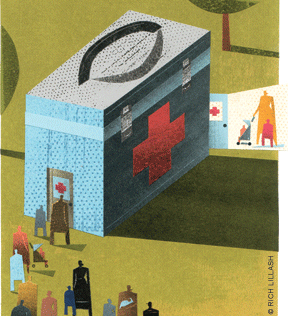
For children, public health insurance is no panacea.
In the national debate over healthcare reform, much attention has been paid to the plight of Americans who lack medical insurance. A study by researchers from the Perelman School of Medicine and the School of Social Policy and Practice recently turned the spotlight on the travails of another group: children covered by public insurance. A stealth audit of pediatric specialty care in Illinois found that 66 percent of children insured by Medicaid or the Children’s Health Insurance Program were unable to get a doctor’s appointment for “moderately severe” medical conditions, including Type 1 diabetes and new-onset seizures, while privately insured children with identical symptoms were turned away only 11 percent of the time. Additionally, publicly insured children who did manage to get an appointment faced average wait times of 42 days, versus 20 for children with private insurance.
The experiment, led by Karin Rhodes, the director of emergency care policy research in Penn’s emergency-medicine department and a senior fellow in the Leonard Davis Institute of Health Economics, was commissioned by Illinois as part of the settlement of a lawsuit by health advocates against the state in 2004. Research assistants posed as mothers of children with urgent health conditions, and made calls to a random sample of 273 clinics representing eight specialties. They placed two calls, spaced one month apart, to each clinic, using a script that varied only by insurance status. If asked, they said a primary-care physician or emergency department had referred them.
Though the results were unsurprising to many veteran physicians, the “disturbing disparities” Rhodes and her colleagues documented attracted substantial attention after their publication in a June issue of the New England Journal of Medicine. Rhodes spoke with Gazette associate editor Trey Popp about her findings, the underlying causes, and possible solutions.
Were you surprised by what you found in Illinois?
We did a year of qualitative work before we did data collection, so we knew it was an issue. But there’s never been a study that was comprehensive that could accurately measure children’s access to specialty care. So we weren’t really sure what we would find. I was actually very disappointed to find this level of disparity.
Is this an ethical issue? If you’re a specialist, you don’t have to take Medicaid patients at all. But the idea that you can say, “We’ll take Medicaid, but not this patient,” or, “We’ll take them but we’ll schedule them for two months out”—what judgment would you pass on that behavior?
It’s not illegal. But I think that common mores would dictate that we want all children to have an opportunity to see a physician when they need one—and not based on insurance status.
You noted in the study that reimbursement to doctors for these average-severity visits is $99 from Medicaid versus an average of $160 from private insurance. Does that gap persist across the spectrum for low-severity to high-severity medical issues?
Yes. Those numbers were 2008 dollars, so the numbers have changed slightly but the proportion is probably roughly about the same.
How do other states compare to Illinois?
First of all, Illinois should be applauded for being the first state to actually measure their access. There are states that are worse, and there are states that are better. But I think the key here is that every state needs to study their access to care and I think we’ve provided the model for doing that.
Was doctors’ reluctance to accept Medicaid patients in Illinois due to the reimbursement difference, or a fear of what might happen if the [cash-strapped] state edged close enough to debt default to decide to suspend payments? Delaying reimbursement payments is a practice that Illinois has a reputation for.
This isn’t quantitative data, but qualitatively, [Medicaid] providers say “Low, slow, and no” reimbursement. But things have changed over time. This particular study grew out of a class-action suit in 2004. As a result of that [suit], [the state] addressed all of those issues … Primary-care reimbursement went up, as did reimbursement for preventative dental care. They totally reorganized their primary-care infrastructure into this primary-care network of medical homes. And all of the qualitative data suggests that that was incredibly successful. Illinois is really concerned about this issue and is actively not only measuring it but moving to improve access and care coordination. And the big concern [is] that other states aren’t doing that. If you don’t measure it, you can’t improve it.
You ask: “Is it better to raise reimbursement rates globally for all specialists, or to give targeted incentives to specialists located in low-resources neighborhoods?” What would be the most effective?
Of those two, the latter. But I’m not basing it just on my hunch. We pulled together an expert advisory team from locally and around the country—people with health-policy [backgrounds], specialists in every area that we audited, and primary-care physicians, economists, people like that. We had them rank various possible fixes. And they definitely [favored] changing reimbursement strategy. Which would include targeted incentives in areas where they were already serving [publicly insured] kids.
Can you give me some examples of the recommendations around that?
An example is to strengthen the primary-care medical-pool model and allow primary-care docs to help with care coordination, rather than leave families to call around trying to find a specialist who will see their kid, who’s, say, having new-onset seizures. But you have to give that primary-care doc access to the specialist. And so you can align your system in a way that pairs a specialist with a group of primary-care physicians. One of the ways of doing that is through accountable care organizations, which is mentioned in the Affordable Care Act.
So in that model, the primary-care physician would not just give a referral, he or she would actually set it up?
Right. The key is to increase the efficiency by which we use specialty care—use it for the ones who need it when they need it. For the clinical conditions where there are benefits, those should be the drivers of whether and how soon a kid gets seen—not their insurance status.
One way of increasing efficiency is to make it easy for those primary-care docs to reach a specialist. You know, I’m an ER doc. So, one, I see all the people who are sent in because the primary-care doc can’t get them access to specialty care. And two, I can call specialists, and they’ll come down and see the patient. The patient doesn’t necessarily need to be admitted, but if they need follow-up in the clinic, they arrange that. That works really well for me here, and that’s why I realize how important that is for a generalist physician. In emergency medicine we are generalists, but primary care is the same way. Sometimes I just have a question for the specialist, and they could say, “Oh, switch around this medication, and I’ll see them in clinic.” Or, “They don’t need to see me, but try them on this, if that doesn’t work, then we’ll make an appointment.” And then, you’ll have specialists more seeing the kids who actually need specialty care, and less wasted referrals.
In addition to kind of giving primary-care docs more access to these specialists, should we make it remunerative, if you’re going to ask them to do more?
Of course. [You have to] align the incentives. It’s all about making sure that people are reimbursed for doing the right thing. And the same thing with the specialists. If they’re going to be answering emails from primary-care docs and providing advice on patients they don’t see, they’re going to need some medical liability protection to do that, because they haven’t seen the kid. Maybe they also need to be reimbursed for providing CME [continuing medical education] to the primary-care doc—“Here’s how we handle this and here are some articles.”
And the primary-care doc, it’s going to take them more time because it’s not a matter of just saying, “We want you to go see the neurologist or I want you to go to the emergency room”—and then they don’t show up with the records and we need to repeat the test. These are expensive ways that our resources are wasted. And I think that even with our decreasing resources, if we increase care coordination and access generally, it’ll make a huge difference in access to care for children and adults alike. We give primary-care docs access to specialists and we reimburse them both appropriately, for the additional time involved. That is not the way that we currently incentivize people … So, restructuring the way we provide specialty care, and shifting around existing resources and aligning the incentives to get the results we want, is the answer.
The Affordable Care Act includes some ideas about accountable-care organizations, but it also envisions another 15 million people being covered by Medicaid. What is the outlook, as the act phases in, for some of these potential problems and solutions that you’re outlining?
It’s well established that having any insurance is better than none. The uninsured get less care. They live sicker and they die younger. And we didn’t study the uninsured; we studied insured children. And you can be sure that if access to care for publically insured kids [is tough], it’s even worse for the uninsured. I applaud the Affordable Care Act for extending coverage. What we have to be careful of is to monitor access as we do so. This can’t be an unfunded mandate … There’s a lot of cash-strapped states—like New Jersey, Texas, Florida. They’re considering deep cuts in their healthcare budgets, their Medicaid budgets. But our results would indicate that Medicaid is already strained to the breaking point. If you’re giving poor access to children who are insured under the Children’s Health Insurance Plan, you know it’s worse for the adults and you know it’s worse for the uninsured. If we keep whittling away at these programs, it’s going to increase the disparities found in this study and it’s going to definitely hurt children and adults alike.




